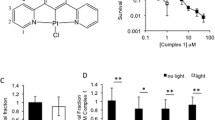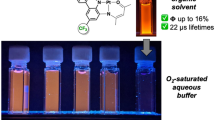Abstract
Carboplatin, an analogue of “classical” cis-diamminedichloridoplatinum(II) (cisplatin), is a widely used second-generation platinum anticancer drug. Cytotoxicity of cisplatin and carboplatin is mediated by platinum–DNA adducts. Markedly higher concentrations of carboplatin are required, and the rate of adduct formation is considerably slower. The reduced toxic effects in tumor cells and a more acceptable side-effect profile are attributable to the lower reactivity of carboplatin with nucleophiles, since the cyclobutanedicarboxylate ligand is a poorer leaving group than the chlorides in cisplatin. Recently, platinum complexes were shown to be particularly attractive as potential photochemotherapeutic anticancer agents. Selective photoactivation of platinum complexes by irradiation of cancer cells may avoid enhancement of toxic side-effects, but may increase toxicity selectively in cancer cells and extend the application of photoactivatable platinum complexes to resistant cells and to a wider range of cancer types. Therefore, it was of interest to examine whether carboplatin can be affected by irradiation with light to the extent that its DNA binding and cytotoxic properties are altered. We have found that carboplatin is converted to species capable of enhanced DNA binding by UVA irradiation and consequently its toxicity in cancer cells is markedly enhanced. Recent advances in laser and fiber-optic technologies make it possible to irradiate also internal organs with light of highly defined intensity and wavelength. Thus, carboplatin is a candidate for use in photoactivated cancer chemotherapy.
Graphical abstract






Similar content being viewed by others
Abbreviations
- CBDCA:
-
Cyclobutanedicarboxylate
- CL:
-
Cross-link
- CT:
-
Calf thymus
- EtBr:
-
Ethidium bromide
- FAAS:
-
Flameless atomic absorption spectroscopy
- IC50 :
-
Compound concentrations that produce 50 % cell growth inhibition
- MTT:
-
3-(4,5-Dimethylthiazol-2-yl)-2,5-diphenyltetrazolium bromide
- [PtCl(dien)]Cl:
-
Chloridodiethylenetriamineplatinum(II) chloride
References
Highley MS, Calvert AH (2000) In: Kelland LR, Farrell NP (eds) Platinum-based drugs in cancer therapy. Humana, Totowa, pp 171–194
Lokich J (2001) Cancer Invest 19:756–760
Jamieson ER, Lippard SJ (1999) Chem Rev 99:2467–2498
Brabec V (2002) Prog Nucleic Acid Res Mol Biol 71:1–68
Kelland L (2007) Nat Rev Cancer 7:573–584
Pavelka M, Lucas MFA, Russo N (2007) Chem Eur J 13:10108–10116
Frey U, Ranford JD, Sadler PJ (1993) Inorg Chem 32:1333–1340
Hay RW, Miller S (1998) Polyhedron 17:2337–2343
Knox RJ, Friedlos F, Lydall DA, Roberts JJ (1986) Cancer Res 46:1972–1979
Blommaert FA, van Dijk-Knijnenburg HCM, Dijt FJ, Denengelse L, Baan RA, Berends F, Fichtinger-Schepman AMJ (1995) Biochemistry 34:8474–8480
Rixe O, Ortuzar W, Alvarez M, Parker R, Reed E, Paull K, Fojo T (1996) Biochem Pharmacol 52:1855–1865
Boulikas T, Vougiouka M (2003) Oncol Rep 10:1663–1682
Terheggen PMAB, Begg AC, Emondt JY, Dubbelman R, Floot BGJ, Denengelse L (1991) Br J Cancer 63:195–200
Blommaert FA, Michael C, Terheggen PMAB, Muggia FM, Kortes V, Schornagel JH, Hart AAM, den Engelse L (1993) Cancer Res 53:5669–5675
Gill I, Muggia FM, Terheggen PMAB, Michael C, Parker RJ, Kortes V, Grunberg S, Christian MC, Reed E, den Engelse L (1991) Ann Oncol 2:115–121
Natarajan G, Malathi R, Holler E (1999) Biochem Pharmacol 58:1625–1629
Tonetti M, Giovine M, Gasparini A, Benatti U, De Flora A (1993) Biochem Pharmacol 46:1377–1383
Kleine M, Wolters D, Sheldrick WS (2003) J Inorg Biochem 97:354–363
Bednarski PJ, Mackay FS, Sadler P (2007) Anticancer Agents Med Chem 7:75–93
Heringova P, Woods J, Mackay FS, Kasparkova J, Sadler PJ, Brabec V (2006) J Med Chem 49:7792–7798
Brabec V, Palecek E (1976) Biophys Chem 4:76–92
Brabec V, Palecek E (1970) Biophysik 6:290–300
Butour JL, Macquet JP (1977) Eur J Biochem 78:455–463
Butour JL, Alvinerie P, Souchard JP, Colson P, Houssier C, Johnson NP (1991) Eur J Biochem 202:975–980
Novakova O, Malina J, Kasparkova J, Halamikova A, Bernard V, Intini F, Natile G, Brabec V (2009) Chem Eur J 15:6211–6221
Bugarcic T, Novakova O, Halamikova A, Zerzankova L, Vrana O, Kasparkova J, Habtemariam A, Parsons S, Sadler PJ, Brabec V (2008) J Med Chem 51:5310–5319
Liskova B, Zerzankova L, Novakova O, Kostrhunova H, Travnicek Z, Brabec V (2012) Chem Res Toxicol 25:500–509
Brabec V, Vrana O, Novakova O, Kleinwachter V, Intini FP, Coluccia M, Natile G (1996) Nucleic Acids Res 24:336–341
Prokop R, Kasparkova J, Novakova O, Marini V, Pizarro AM, Navarro-Ranninger C, Brabec V (2004) Biochem Pharmacol 67:1097–1109
Fichtinger-Schepman AMJ, Van der Veer JL, Den Hartog JHJ, Lohman PHM, Reedijk J (1985) Biochemistry 24:707–713
Zakovska A, Novakova O, Balcarova Z, Bierbach U, Farrell N, Brabec V (1998) Eur J Biochem 254:547–557
Brabec V, Kasparkova J, Vrana O, Novakova O, Cox JW, Qu Y, Farrell N (1999) Biochemistry 38:6781–6790
Zerzankova L, Suchankova T, Vrana O, Farrell NP, Brabec V, Kasparkova J (2010) Biochem Pharmacol 79:112–121
Brabec V, Leng M (1993) Proc Natl Acad Sci USA 90:5345–5349
Farrell N, Qu Y, Feng L, Van Houten B (1990) Biochemistry 29:9522–9531
Perumareddi JR, Adamson AW (1968) J Phys Chem 72:414–420
Fry HC, Deal C, Barr E, Cummings SD (2002) J Photochem Photobiol A Chem 150:37–40
Mackay FS, Woods JA, Heringova P, Kasparkova J, Pizarro AM, Moggach SA, Parsons S, Brabec V, Sadler PJ (2007) Proc Natl Acad Sci USA 104:20743–20748
McWhinney SR, Goldberg RM, McLeod HL (2009) Mol Cancer Ther 8:10–16
Heinzlef O, Lotz J-P, Roullet E (1998) J Neurol Neurosurg Psychiatry 64:667–669
Acknowledgments
This work was supported by the Czech Science Foundation (grants 301/09/H004 and P301/10/0598).
Author information
Authors and Affiliations
Corresponding author
Rights and permissions
About this article
Cite this article
Mlcouskova, J., Stepankova, J. & Brabec, V. Antitumor carboplatin is more toxic in tumor cells when photoactivated: enhanced DNA binding. J Biol Inorg Chem 17, 891–898 (2012). https://doi.org/10.1007/s00775-012-0906-z
Received:
Accepted:
Published:
Issue Date:
DOI: https://doi.org/10.1007/s00775-012-0906-z




